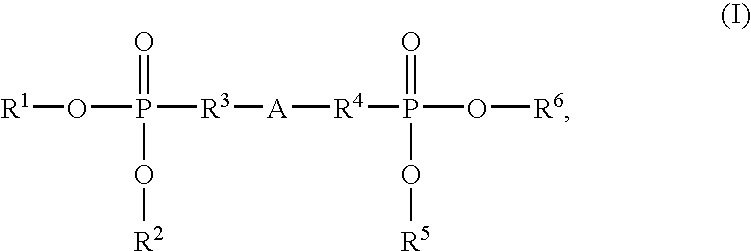Halogen-free, flame-retardant polyurethane foams
a flame-retardant, polyurethane foam technology, applied in the field of halogen-free flame-retardant polyurethane foams, can solve the problems of complex use of abovementioned liquids, severe corrosion phenomena on plant components, and the abovementioned liquids now fail to meet these requirements, etc., to achieve low fogging, easy processing, and convenient availability
- Summary
- Abstract
- Description
- Claims
- Application Information
AI Technical Summary
Benefits of technology
Problems solved by technology
Method used
Image
Examples
Embodiment Construction
[0097]The parts stated are based on weight.
Materials Used
[0098]
ComponentFunctionDescriptionAPolyolArco1 ® 1105 (Bayer MaterialScience),Polyether polyol whose OH number is 56 mg KOH / gBBlowing agentWaterCCatalystNiax ® A-1 (GE Silicones), 70% strength solution ofbis(2-dimethylaminoethyl) ether in dipropylene glycolDCatalystDesmorapid ® SO (Rheinchemie), stannous 2-ethylhexanoateEStabilizerTegostab ® B 8232 (Degussa), silicone stabilizerF1Flame retardantTris(dichloroisopropyl) phosphate, TDCP,CAS reg. no. 13674-87-8F2Flame retardantDiphenyl cresyl phosphate, CAS reg. No. 26444-49-5F3Flame retardantFormula IVF4Flame retardantFormula VIF5Flame retardantFormula VIIF6Flame retardantFormula VIIIGDiisocyanateDesmodur ® T 80 (Bayer MaterialScience),tolylene diisocyanate, isomer mixture
Production of Flexible Polyurethane Foams
[0099]The components whose nature and amount is stated in table 1, with the exception of the diisocyanate (component G) were mixed to give a homogeneous mixture. The diis...
PUM
| Property | Measurement | Unit |
|---|---|---|
| Temperature | aaaaa | aaaaa |
| Fraction | aaaaa | aaaaa |
| Fraction | aaaaa | aaaaa |
Abstract
Description
Claims
Application Information
 Login to View More
Login to View More - R&D
- Intellectual Property
- Life Sciences
- Materials
- Tech Scout
- Unparalleled Data Quality
- Higher Quality Content
- 60% Fewer Hallucinations
Browse by: Latest US Patents, China's latest patents, Technical Efficacy Thesaurus, Application Domain, Technology Topic, Popular Technical Reports.
© 2025 PatSnap. All rights reserved.Legal|Privacy policy|Modern Slavery Act Transparency Statement|Sitemap|About US| Contact US: help@patsnap.com



